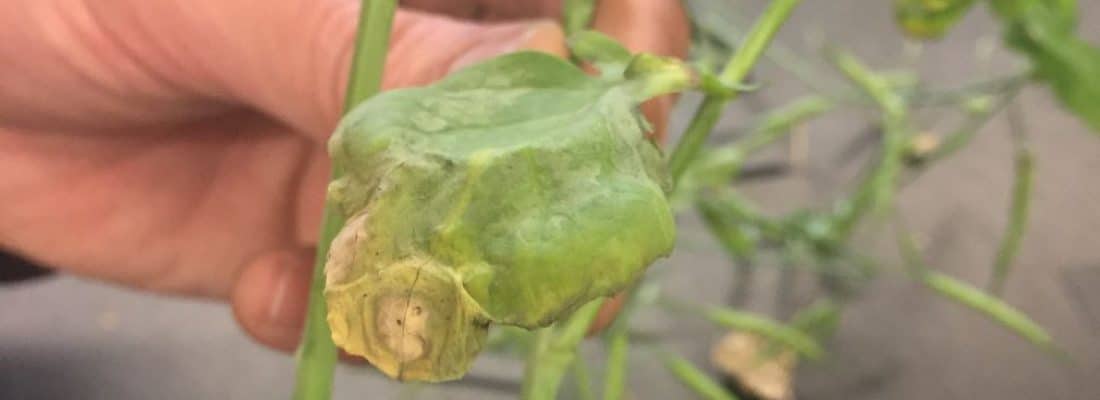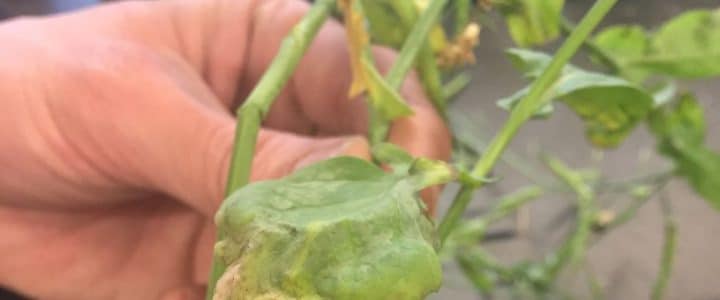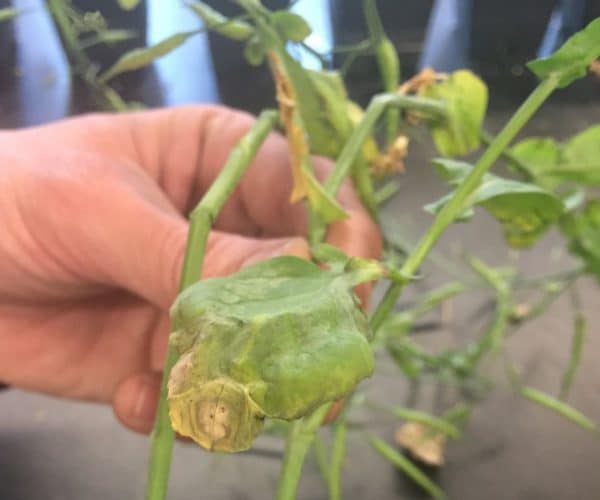- 1 Role of potassium in canola plants
- 2 Potassium supply from the soil
- 3 Important tips for potassium fertilizer management
- 4 Canola response to potassium fertilizer
- 5 Fate of applied of potassium fertilizer
- 6 Identifying deficiency symptoms
- 7 Placement of fertilizer
- 8 Timing of application
- 9 Product choices
The macronutrient potassium (K+) is required in large amounts by canola, similar to nitrogen. In spite of the large requirement, canola yield responses to potassium fertilizer (potash) are infrequent, due to ample soil potassium reserves on most prairie soils, and canola’s strong ability to absorb potassium. Responses to potassium fertilizer are more likely on lighter-textured soils or organic soils, such as peat.
Role of potassium in canola plants
Potassium is different from most other essential nutrients since it does not become part of structural components in the plant. Instead, most of the potassium in plants remains dissolved in the cell sap. This allows for a fairly rapid release of potassium back to the soil.
Enzyme activation is one major function of potassium in the plant. Enzymes are protein complexes that catalyze chemical reactions. More than 60 enzymes need to be activated by potassium. This activation occurs when potassium cations (K+) bind to the enzyme surface, changing the enzyme shape, and allowing the enzyme’s active site to attach to its substrate more rapidly and properly. For example, potassium stimulates the activity of starch synthase (an enzyme) that catalyzes starch formation from glucose. While other cations can also stimulate this enzyme, potassium is the most effective. In potassium deficient plants, the lack of stimulation of the starch synthase results in an accumulation of soluble sugars and nitrogen compounds, and a decrease in starch.
Potassium also helps facilitate water use regulation in the plant. The favourable water status is maintained in several ways. Potassium cations dissolved in cell sap perform major osmotic functions. Osmosis is the tendency for water levels to equalize between different areas separated by a porous membrane. Dissolved ions such as potassium cations (K+) attract water and thus are osmotically active substances. Potassium is the main dissolved ion in cell sap and provides most of the osmotic pull that draws water into roots.
Potassium cations also maintain the water management in plants through their crucial role in regulating water loss (called transpiration) from pores (stomata) in the leaves. Although the stomata must open to allow movement of carbon dioxide and oxygen in and out of the leaves, water loss also occurs. This transpiration creates a gradient that pulls water and nutrients up through the xylem to the leaves. However, plants cannot afford excessive water loss and need to regulate the stomata opening. For example, photosynthesis stops during darkness, and the need for nutrients and water decreases greatly during night. Plants have developed a system that closes stomata during the dark or during drought. Potassium cations, in combination with chlorine, calcium and certain hormones, are responsible for governing the opening and closing of the stomata. Upon receiving a signal induced by darkness, potassium cations (K+) and choride anions (Cl–) are pumped from the two guard cells surrounding the stomata, causing a loss of turgidity of the guard cells and thus allowing the pore to close. For this reason, potassium deficient plants often have higher transpiration rates and display wilting.
Potassium’s osmotic activity also provides the physical force that expands cells during growth. New cells accumulate potassium cations (K+) and associated anions (such as Cl–) in the large central vacuole that occupy 80 to 90 per cent of the cell volume. The potassium cations (K+) attract water and inflate the cell, stretching it to a new larger size. Potassium-deficient plants can exhibit low growth rates and small cells.
Energy relations in the plant are influenced by potassium. Potassium affects photosynthesis at several levels. Potassium (K+) is the main ion that counterbalances the hydrogen (H+) flux during photosynthesis in the chloroplasts. Potassium also maintains a favourable pH gradient in the chloroplasts for making phosphate energy compounds. Potassium helps the translocation of photosynthate sugars by maintaining a high pH in phloem tubes needed for loading, and by maintaining osmotic gradients needed for sap flow.
Potassium is needed for nitrogen uptake and protein synthesis. Potassium cations are the major counter ions that balance nitrate during transport and storage in vacuoles. Many steps of protein synthesis require high potassium levels.
Canola potassium uptake is rapid during the early growth stages and tapers off by the end of flowering. As a result, the potassium level is highest in seedling canola and declines steadily up to maturity1.
Under high potassium fertility and good growth, canola can absorb more potassium than apparently needed, a situation termed ‘luxury consumption.’ As canola matures, the potassium level in leaves declines while the stem level increases. By harvest, the stem and straw material contain about one to two per cent potassium. In contrast to nitrogen and phosphorus, the potassium content of the seed (0.8 to one per cent potassium) is low relative to the stem. Unlike potassium in the vegetative parts, seed potassium is probably complexed with phytate (the principle phosphorus storage form) as a salt.
Potassium supply from the soil
Western Canadian soils generally contain ample plant available potassium due to an abundance of potassium minerals (such as mica and feldspar) in the parent material (three to four per cent potassium). There is often 17,000 to 56,000 kilograms per hectare (15,000 to 50,000 pounds per acre) of potassium in the top 15 centimetres of Prairie mineral (non-peat) soils. The weathering of these minerals slowly releases potassium cations (K+) held in crystal structures, resulting in only about one per cent of total soil potassium typically being available for plant uptake. Approximately 10 to 20 per cent of the total soil potassium is slowly available from smaller mica and feldspar particles and certain clays. This is common in southwest Saskatchewan. But the feldspar and mica content declines towards northeast Saskatchewan, which is why potassium deficient soils can occur in northeast Saskatchewan.
The various potassium pools are in dynamic equilibrium and the losses due to leaching or erosion are usually small. As potassium is removed by plant uptake, additional potassium is released from the mineral soils to become available. Available potassium moves to plant roots by diffusion through the soil only up to six millimetres (1/4 of an inch). Therefore, the equilibrium process that repeatedly moves potassium from the slowly available to readily available pool is very important for potassium nutrition. The rate of movement from the slowly available to readily available pool varies among soils due to differences in mineralogy and clay content. This variation in potassium dynamics creates problems for traditional soil testing. An extractant that measures plant available potassium in soil solution and exchangeable potassium over a short time period does not assess the replenishment power.
The Plant Root Simulator (PRS) from Western Ag Labs uses a negatively charged soil probe to estimate the plant available supply of potassium, and is another approach in estimating potassium soil fertility.
Important tips for potassium fertilizer management
- Most Western Canadian soils have enough potassium (K) to meet canola needs, so soil test levels are unlikely to change much over time. Most potassium taken up by plants remains in the plant biomass, not the seed, and is returned quickly to the soil. Eroding clay particles restock available soil potassium levels. Soils that may show potassium deficiency are sandy soils with low clay content, especially in forages where a large percent of the biomass is removed each year.
- Cereals are more likely to show symptoms when soil levels drop below 300 pounds per acre of potassium. Symptoms may not be obvious in canola until soil reserves drop below 150 pounds per acre.
Canola response to potassium fertilizer
Yield
Canola needs 2.5 pounds per acre of potassium (K) for every bushel of seed yield. A 50 bushel per acre canola crop will take up approximately 125 pounds per acre of potassium.
Many fields do not show a potassium response because:
- Soil reserves are generally high across the Prairies. Prairie mineral (non-peat) soils often have 17,000-56,000 kilograms per hectare (15,000-50,000 pounds per acre) of potassium in the top 15 centimetres (six inches). However, only about one per cent of this potassium is available for plant uptake at any given time.
- Eroding clay particles restock available soil potassium levels.
- Canola has a strong ability to find and absorb potassium.
- Seventy-five per cent of potassium taken up by canola, wheat, barley and peas is returned to the field in the straw. The ratio is higher for oats, and lower for lentils and flax. Potassium releases quickly from plant residue because most is in inorganic form.
If soil tests show less than 300 pounds per acre (150 parts per million) of potassium, then canola may show a yield response to a potassium application. Response is more likely in soils with less than 150 pounds per acre.
Quality
Potassium applications have not been shown to help with canola seed quality (oil or meal protein content), disease resistance or lodging. However some benefits, particularly with regard to reduced diseases like root rots, have been shown with applications of potassium chloride (KCl, with 0-0-60 blend) on cereals.
Economic
Canola rarely responds to applied potassium, even under conditions where cereals normally respond. Critical levels are often stated to be around 280 kilograms per hectare (250 pounds per acre) of potassium, or 112 parts per million, in the top 15 centimetres (six inches). But research indicates that canola will not consistently or economically respond to fertilizer potassium unless the soil test is very low (78 to 112 kilograms per hectare , 70 to 100 pounds per acre or 35 to 50 parts per million of potassium.
Fate of applied of potassium fertilizer
Very sandy or peaty soils are the most likely soil types to have very low potassium soil test values. Other factors that increase the likelihood of potassium deficiency are:
- free lime in the rooting zone
- acid soil
- poor drainage
- cool temperatures
- soil compaction
- shallow root zone
Identifying deficiency symptoms
Potassium deficiency symptoms include:
- A yellowish brown “scorched” look at leaf margins edges and a mottled appearance in older leaves
- Bottom leaves will yellow off first (due to potassium being mobile in the plant and moving the nutrient from bottom leaves to top leaves)
- Uneven pod maturity
Potassium deficiency reduces overall canola growth, but to a lesser degree than a nitrogen or phosphorus deficiency. Since potassium is mobile within the plant, deficiencies are first visible in older leaves. The edges and areas between veins of older leaves tend to turn pale green or yellow, followed by withering. The yellowing can occur first in middle leaves before older ones, if observed at bolting to flowering stages. In severe cases, leaves die but remain attached to the stem. Small white spots can develop on leaves. Plants are prone to wilting during midday.
Confirm if there is a potassium deficiency by looking at cereal crops. Cereals are more sensitive to potassium deficient soils than canola. Symptoms on cereals appear as a burning or scorching of the lower leaves. Burning begins at the tip of the leaf and continues down the leaf margin.
Soil tests are imperfect because potassium pools in the soil are in dynamic equilibrium and available potassium is constantly replenished. As potassium is removed by plant uptake and through leaching on sandy soils, additional potassium is released from the mineral soils and made available. Available potassium moves to plant roots by diffusion through the soil only up to six millimetres (1/4 of an inch).
Therefore, the equilibrium process that repeatedly moves potassium from the slowly available to the readily available pool is very important for potassium nutrition. The rate of movement from the slowly available to readily available pool varies among soils due to differences in minerals and clays. This variation in potassium dynamics creates problems for soil testing. An extractant that measures plant available potassium in soil solution and exchangeable potassium over a short time period does not assess the replenishment power. Unfortunately, tests that measure the replenishment power are time-consuming and cost-prohibitive.
Research in Alberta indicates that soil tests do not adequately reflect residual fertilizer potassium when high rates (up to 670 pounds per acre) are applied to very potassium-deficient soils. Following the high-rate applications, soil test potassium was still in the deficient range and subsequent crops showed little or no response to additional potassium fertilizer. Therefore, when high rates of potassium fertilizer are applied to very potassium-deficient soils, any subsequent need for additional fertilizer should be determined on the basis of crop response, rather than solely on the basis of a soil test.
Placement of fertilizer
Potassium is relatively immobile in the soil (less mobile than nitrogen, but more than phosphorus), so placement near the roots is important. Side banding is the best choice, as seed-placed potassium can damage seedlings.
The relative immobility of potassium in the soil is due the potassium cations (K+) being readily adsorbed to the negative surface charges on clay particles and organic matter. Potassium can also be fixed into the clay lattice structure of certain clay types. Potassium is more mobile in sandy soil and therefore can be leached in these soil textures. In most soils, potassium is much less mobile than nitrate, but somewhat more mobile than phosphate. This relative immobility means that fertilizer placement will greatly affect uptake efficiency. Ensure application methods minimize contact with soil and increase root contact. Since canola responses to potassium fertilizer are rare on the Prairies, there has been limited potassium placement research in this crop.
Seed row
The high salt index of potassium fertilizer limits the amount that can be safely applied near the seed. Canola has a much lower tolerance to seed-placed potassium than cereals, and stands can be reduced if seed-placed potassium rates exceed safe rates, especially with drills that have low seedbed utilization (such as double disc drills). Higher rates of potash fertilizer can be safely seed-placed as the seedbed utilization is increased. If other nutrients such as nitrogen or phosphorus are also seed placed, this reduces the safe rate of seed-placed potassium. Safe seed-placed potassium rates will be the same as safe phosphorus rates. When potassium and phosphorus are both seed-placed, the combined rate should not be higher than the safe seed-placed phosphorus rate. Good seedbed moisture, higher clay and organic matter contents help reduce the severity of seedling damage from seed-placed potassium fertilizer. However, most potassium deficient soils are sandy, and are sensitive to seed-placed potassium.
Band
Due to canola’s sensitivity to seed-placed potassium fertilizer, a band placement away from the seed row is more advisable. Sideband placement is an efficient method, and the separation between fertilizer and seed reduces the risk of damaging germinating seeds. Banding prior to seeding is also an efficient and safe method, and potassium fertilizer can be banded together with other nutrients. Banding efficiency should not differ greatly between fall and spring unless the soil is very sandy and subject to leaching loss under conditions of high snowmelt or spring rainfall.
Broadcast
The broadcast-incorporation application method is less efficient, and probably requires rates double that of banding to achieve a similar crop response. However, in situations where banding equipment is not readily available and seed placement is too risky, broadcast and incorporation may be useful and not overly expensive due to the relatively low cost of potassium fertilizer. The higher fertilizer rates necessary for broadcast potassium may also benefit subsequent crops with a higher potassium response than canola.
Foliar
Foliar potassium products are available but with very little research. It is unknown whether there is an economic response and effective rescue treatment for potassium deficiencies, but foliar applied potassium rates are much lower than banded rates and will not supply enough of the nutrient achieve the maximum yield potential.
Timing of application
Banding efficiency should not differ greatly between fall and spring unless the soil is very sandy and subject to leaching loss under conditions of high snowmelt or spring rainfall. In that case, spring is preferred.
Product choices
Available forms
Potassium chloride (KCl, with a nitrogen-phosphorus-potassium blend of 0-0-60) is the most common potassium fertilizer because of its lower relative cost and high potassium analysis. It comes from potash.
Potassium sulphate (K2SO4, with a nitrogen-phosphorus-potassium-sulphur blend of 0-0-50-17) tends to be a more expensive potassium product, but it provides some sulphur as well. The salt measurement from a K2SO4 solution is less than a third of a similar concentration of a potassium chloride solution.
Special formulations
Potassium thiosulphate (with a nitrogen-phosphorus-potassium-sulphur blend of 0-0-25-17) is sold as a liquid for top dress applications. If also using for sulphur, keep in mind that thiosulphate must convert to sulphate to be available to plants. This can take a week or two in warm soils.
There are no potassium fertilizer options with inhibitors and coatings or inoculants.
- Malhi, S.S., Brandt, S., Ulrich, D., Lafond, G.P., Johnston, A.M., & Zentner, R.P. 2007. Comparative nitrogen response and economic evaluation for optimum yield of hybrid and open-pollinated canola. Can. J. Plant Sci., 87, 449-460. [↩]




